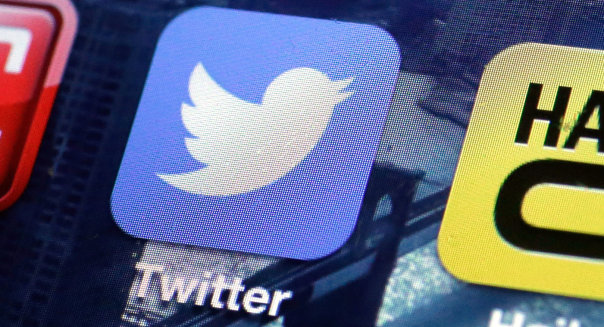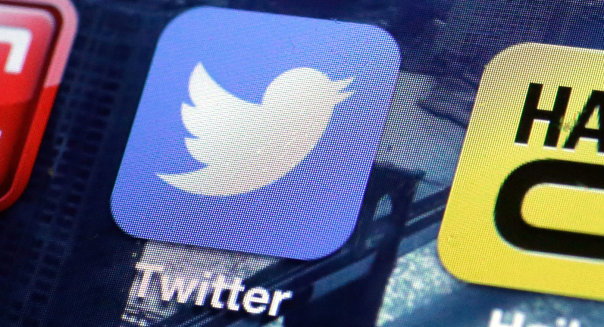
SAN FRANCISCO — Retired schoolteacher Donald Hovasse signed up for Twitter about a year ago at the urging of his daughter. He lost interest after trying the service a few times and finding lots of celebrities but few of his friends using the online social network.
“I didn’t really get the point of it at all,” said the Las Vegas resident. “Most of them were people I wasn’t interested in hearing what they had to say anyway.” He said, however, that he does check Facebook everyday to see what his friends are up to.
Hovasse’s experience highlights a risk for investors as Twitter marches towards this year’s most anticipated initial public offering in the United States, expected to begin trading on the New York Stock Exchange in mid-November.
According to a Reuters/Ipsos poll, 36 percent of 1,067 people who have joined Twitter say they don’t use it, and 7 percent say they have shut their account. The online survey, conducted Oct. 11-18, has a credibility interval, a measure of its accuracy, of plus or minus 3.4 percentage points.
In comparison, only 7 percent of 2,449 Facebook members report not using the online social network, and 5 percent say they have shut down their account. The results have a credibility interval of 2.3 percent.
People who have given up on Twitter cite a variety of reasons, from lack of friends on the service to difficulty understanding how to use it.
Twitter declined to comment for this story, saying it is in a quiet period ahead of its IPO.
Twitter’s attrition rate highlights a challenge that has dogged the online messaging site over the years: while it has managed to enlist many high-profile and avid users, from the pope to President Barack Obama, Twitter has yet to go truly mainstream in the way Facebook (FB) has.
Convincing ordinary people to think of Twitter as an indispensable part of their lives is key to the company’s ability to attract advertisers and generate a profit.
Twitter reported it had 232 million “active” users — people who access the service at least once a month — at the end of September, up 6.1 percent from the end of June. Twitter’s quarter-over-quarter growth in active users hasn’t exceeded 11 percent since June 2012.
When Facebook was a similar size, its active users were increasing by more than 20 percent every quarter, and it wasn’t until the social network neared the half-a-billion member mark that its user growth decelerated to 12 percent.
“Twitter is a great service, it’s still got growth in front of it. But in my opinion, I would say the opportunities are less than that of Facebook, and it has to be valued appropriately,” said Dan Niles, chief investment officer of tech-focused hedge fund firm AlphaOne Capital Partners.
“The data would seem to imply that the ultimate revenue potential for this company is less than for Facebook,” Niles said, referring to Twitter’s number of active users.
Twitter’s revenue in the third quarter more than doubled from the year before to $168.6 million, while its net loss tripled to $64.6 million. Analysts expect Facebook, which is due to report its third-quarter results later this month, to bring in $1.9 billion in quarterly revenue.
Quitters
Twitter aims to become the “fabric of every communication in the world” and to eventually reach every person on the planet, Chief Executive Officer Dick Costolo has said. Still, Twitter acknowledged in its IPO prospectus that “new users may initially find our product confusing.”
The company prides itself on staying true to its roots: it lets people send 140-character messages and doesn’t pack in scads of extraneous functions. Since its inception, Twitter has resisted overtly manipulating how people use its platform, instead preferring conventions to be formed organically.
As a result, new users often find it initially difficult to grasp how discussions ebb and flow, complaining that features such as the “hashtags” that group Tweets by topic, abbreviations for basic functions (for instance, RT for retweet) and shortened Web links, are geared towards a technologically savvy crowd.
“The average person that’s coming on here, they’re still baffled by it,” said Larry Cornett, a former executive at Yahoo (YHOO) and designer at Apple (AAPL), who now runs product strategy and design consulting firm Brilliant Forge.
“If they want the mass adoption and that daily engagement, they have to make it really easy for people to consume.”
According to the Reuters/Ipsos poll, 38 percent of 2,217 people who don’t use Twitter said they didn’t find it that interesting or useful. Thirteen percent said they don’t understand what to use Twitter for. The results have a credibility interval of 2.4 percent.
Twitter has taken steps to help new members. In December 2011, it introduced a new “Discover” section to highlight the most popular discussion topics based on a person’s location and interests.
The company also simplified some features and rolled out new tools that embed photos and videos directly in a person’s tweet stream, making for a richer and easier-to-use experience.
These changes may mean that Twitter’s retention rate for the past several months is better than its overall retention rate, which includes people who joined years ago, say analysts.
Brian Wieser, an analyst with Pivotal Research Group, said Twitter’s current user base is already big enough to be valuable to advertisers. Investors need to get more comfortable with the idea that Twitter isn’t for everyone, he said.
“The practical matter is that this is a niche medium,” he said. “Their appeal, they will never be as broad as Facebook.”
For years, security professionals have emphasized the importance of shredding your personal documents before you throw them out. But Holland notes that shredding isn’t as much of a priority as it used to be. "There aren’t nearly as many documents with personal information out there as there were even just two years ago," he explains. "These days, it’s much easier to get your information off your computer."
Shredding
Passwords are your first line of defense against intruders. But, as Holland points out, even the most careful people sometimes have password breaches. "I’ve helped chief privacy officers from health care and security firms," he notes. "If they’re getting hit, then anyone is vulnerable." While Holland notes the importance of having a good password, he emphasizes that the most important thing is paying attention to password breach notifications. If you hear that one of your passwords may have been breached, he counsels, change it immediately. And, because many of your accounts may be linked, he notes, it’s not a bad idea to change the rest of your passwords as well.
Strong Passwords
One piece of advice that you don’t often hear is to keep on top of software updates. But, Holland argues, updating your operating system, your software, and your security programs is one of the easiest and most important ways to ensure your security. Software companies spend a lot of time and money trying to stay ahead of online intruders — it only makes sense to take advantage of their work.
Keep on Top of Updates
Even if you are convinced that your security is state-of-the-art and your password is unbreakable, it never hurts to double-check your most sensitive accounts. Holland suggests regularly checking your bank and credit card statements to ensure that there aren’t any inappropriate charges on your accounts. As a side benefit, this is also a great way to catch any unexpected fees that your bank may try to spring on you.
Double-Check Your Bank
When a breach happens, a fast response can mean the difference between a minor annoyance and a major pain in the neck. With that in mind, Holland suggests talking to your bank about having transaction alerts placed on your account. Every time your account is credited with a transaction over a particular amount — $50, for example — your bank will send you an e-mail or text notification. If it’s an expected transaction, you can discard the message; if not, you’ll be able to respond immediately.
Set E-Mail and Text Alerts
Every year, you are entitled to a free credit report from each of the reporting bureaus. Holland suggests taking advantage of this free service, noting that your credit report is a great way to track your outstanding debts and ensure that nobody is trying to open false accounts in your name. He emphasizes, however, that the best way to get your free report is by going to AnnualCreditReport.com, not FreeCreditReport.com. "That site’s a scam," he laughs.
Check Your Free Credit Report
Why Your Bank Thinks Someone Stole Your Credit Card
9 Scary Ways Criminals Use Facebook
8 Things to Never Keep in Your Wallet
The ‘Scammiest’ Words on the Internet
More from DailyFinance:


Leave a Reply